
|

|
Viking Age Arms and Armor
Overview of Weapons in Viking-Age Society
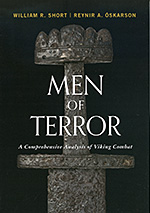 |
Much of the text presented on this page is out-of-date. Until we find time to make the needed updates to this page, we strongly encourage readers to look at this topic as it is presented in our new book, Men of Terror, available now from your favorite book seller. |
|
Since weapons and their use were central to Viking age culture, we study them to learn more about the Viking-age people, and about their culture and society, and about the poetry and literature that is one of their great, enduring legacies. In this series of articles, we discuss not only the weapons and their use, but also their place in Viking-age society. Weapons were very much a part of everyday life in the Viking age. Virtually every free man owned and carried a weapon and was familiar with its use. The right to carry and use weapons was one of the traditional fundamental rights of free men in Viking society. |
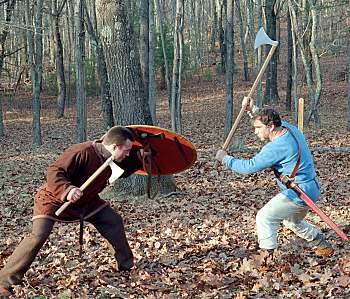 |
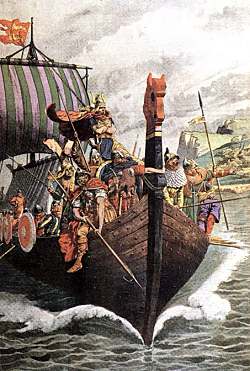 |
Many people think that the life of a Viking warrior looked something like the scene to the left. In reality, Viking-age life was more like the scene to the right. The vast majority of people in the Viking age were farmers and traders. |
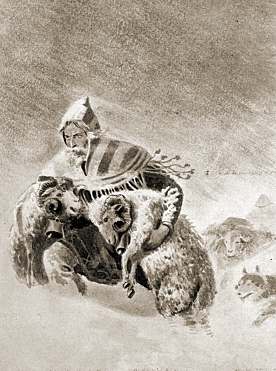 |
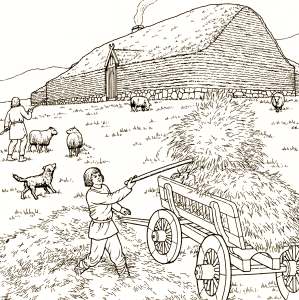 |
Yet, in no way was Viking society a military society. Rather, it was an agricultural society in which virtually everyone had to grow their own food. But it was also a society in which weapons played a central role, and in which the use of weapons was a common occurrence. |
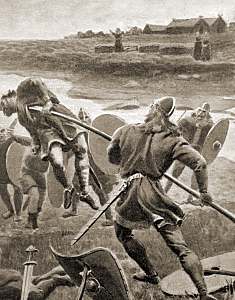 |
There are many reasons why weapons and combat were a central part of Viking-age society, but it was not due to the Viking people being lawless barbarians, as is often seen in popular media. In fact, the opposite was the case: law and adherence to law was a central part of Viking culture, as described in the article on law.
In part, weapons were important because Viking society was an honor-based society. Honor was more important than any mere physical possession, and the English word "honor" scarcely begins to describe the value and importance Viking-age people placed on their honor, as discussed in the article on honor.
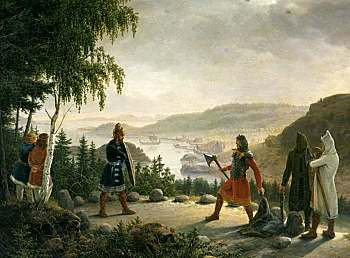 |
Any attempt to diminish honor was answered with weapons, or the credible threat of the use of weapons. The law permitted it. Society demanded it. Lost honor could be recovered in a number of ways, including legal proceedings, a duel, or a reprisal attack. A reprisal attack need not be made to the person who originally gave offense. The attack could be made to any adult male of equivalent status in the extended family. And so, lethal attacks could take place at any time, at any place, to any adult male, even if the target of the attack had no knowledge of the dispute. |
|
As a result, Viking-age people were constantly prepared to use their weapons, and kept them close at hand. Hávamál (verse 38), a Viking-age poem of advice, tells us never to be more than one footstep away from our weapon, no matter where or when. |
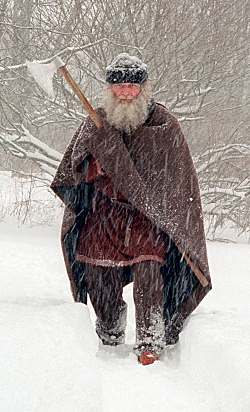 |
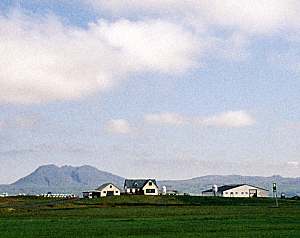 |
The sagas tell us that farmers carried their weapons as they worked their fields. Brennu-Njáls saga (ch.111) says that one morning, Höskuldur went out to work his field at his farm at Ossabćr (shown to the left as it appears today). He picked up his seed bag in one hand, and his sword in the other and went out to sow the seeds. His sword was insufficient protection against the five men who waited to ambush him. |
|
Men slept with their weapons hung on the wall next to the bed, ready for instant use should an attack take place in the night. The master's bed closet at a reconstruction of the Viking-age house at Stöng is shown to the right, with the farmer's axe and sword hung by the bed, ready for use. |
 |
While it is likely that every free man had at least one weapon, it's also likely that few men had more than one. In the Viking age, iron was difficult and time-consuming to create, and thus, iron was expensive. Anything requiring a lot of iron in its construction, such as a weapon, was an expensive item. Further, some weapons, such as swords, were so difficult to fabricate that only highly specialized smiths could make them, further adding to their value and prestige.
 |
As a result, a typical man was armed with nothing more than a shield and a axe, or perhaps a shield and spear. A poor man might simply use the wood axe from the farm, if he had nothing else available. |
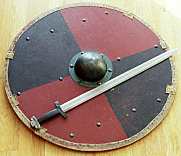 |
A more wealthy man might own a sword, which in the Viking age, was worth a dozen or more milk cows. Since having just one more milk cow might mean the difference between starving to death and surviving over the winter in the Viking age, a sword was a valuable possession indeed. |
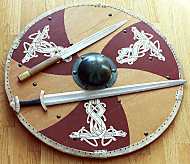 |
A man with more wealth, perhaps someone who returned from successful Viking raids, might replace his ordinary sword and shield with ornate, prestige weapons. Perhaps he might add a second weapon, such as a sax (short sword), to his set of arms. |
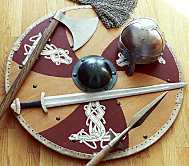 |
Only the extremely wealthy, those at the top of the social hierarchy could afford to own the full panoply of weapons and defenses shown here: axe, spear, mail, helmet, along with sword and shield. Such displays of wealth must have been rare in the Viking age. A study of Viking age burials in western Norway revealed that of the graves in which weapons were found, 61% of them contained one weapon, while only 15% contained three or more. |
Hurstwic has done a careful study of how frequently various weapons are mentioned in the Sagas of Icelanders, a resource that we believe is perhaps our most important source of information about Viking-age fighting. Yet the distribution of weapons described in the sagas does not match the distribution found in archaeological sources.
|
The plot to the right shows the distribution of weapons that are mentioned in the Sagas of Icelanders. Each mention (even if of the same weapon) was counted, even if the mention was only a casual reference to the weapon in a non-combative situation. The data are taken from the Hurstwic study of weapons and combat in the sagas. Some of the unknown weapons categorized as halberd in the study were moved into broader categories for this plot, based on how they were used. For example, the atgeir, used primarily for thrusting, was moved into the spear category for this plot. |
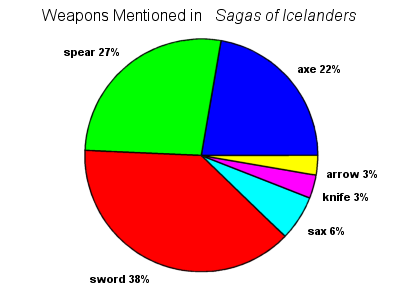 |
|
The plot to the right shows the distribution of weapons that are used for an attack in the Sagas of Icelanders. Each attack (even if with the same weapon) was counted, but each count represents the use of the weapon in a combative situation. The data are again taken from the Hurstwic study of weapons and combat in the sagas. Again, some of the unknown weapons categorized as halberd in the study were moved into broader categories. |
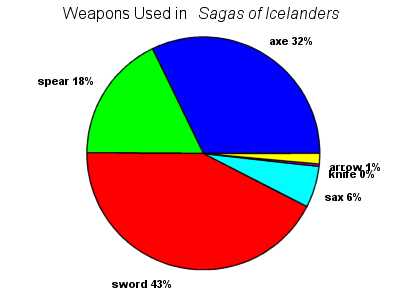 |
|
Lastly, the plot to the right shows the distribution of weapons found in Iceland in a Viking-age context. Most are grave finds, but some are loose finds. The plot was made by combining data from Daxböck's study (2008) with information from Kristján Eldjárn and Adolf Friđriksson (2000) and from sarpur.is, the on-line museum catalog of Iceland. There are many discrepancies between the data from the sagas and the data from the archaeological records. Swords are more common in the saga texts than in the weapons finds. The saga authors themselves tell us that swords were not common in the Viking age (Fóstbrćđra saga, ch. 3). Perhaps sagas were more commonly written about men who had the wealth and status to carry and use a sword. Perhaps swords were treated differently when selecting grave goods, compared to spears or axes. Saxes are less commonly found in the archaeological record, but part of that might be explained by how the artifacts have been categorized. Artifacts that some might categorize as saxes are categorized as knives in the modern archaeological records. |
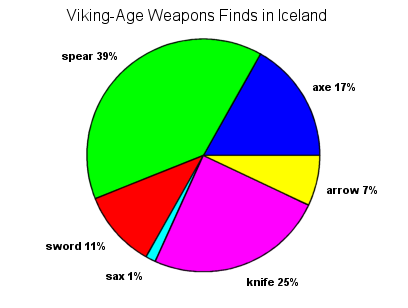 |
The right to carry weapons was limited to free men. Both women and the unfree (such as slaves) were prohibited from carrying weapons. There are examples in the stories of both slaves and women owning weapons, but the stories and the lawbooks make it clear that their carrying those weapons was not permitted. With few exceptions, women's graves do not contain weapons, in the way that men's graves commonly do. Weapons were not a part of the lives of women.
The prohibition against women carrying weapons carried with it some level of protection against violence. It was considered shameful in the extreme to harm a woman, even accidentally, in a fight. That is not to say that such attacks never occurred, but when they did occur, honorable men condemned them. Men banded together to hunt down and kill the guilty party immediately for his shameful deed. Even playful violence was objectionable. In Droplaugarsona saga (chapter 10), Helgi chided his men for playfully throwing a snowball at a woman. "Only an idiot attacks a woman."
But this does not mean that women never used weapons. People did whatever was necessary to survive, and that included picking up a weapon and using it. Men, women, and children used weapons with lethal intent in the Viking age. Honor, courage, independence, and a strong will were admired in both men and women. While generally, weapons use was left to men, women used weapons when they saw the need, often when they felt that men were not behaving honorably.
 |
For example, Gísla saga (chapter 37) tells how Ţórdís Súrsdóttir was dismayed when her husband Börkur welcomed her brother's killer, Eyjólfur, into their home at Helgafell (left). Seeing her brother's weapon on the floor by Eyjolfur's feet during the meal, Ţórdís seized the weapon and struck up at him, giving the man a grievous wound. Börkur seized Ţórdís to strike her down, but her young son intervened. She divorced Börkur on the spot, and her son later drove him out of the house. |
 |
In some cases, women fought without weapons. In Harđar saga (chapter 39), an assassin was sent to kill Refur. As he stood over Refur's bed at night, the killer was spotted by Refur's mother, Ţorbjörg. She called out a warning, but the assassin struck, causing a grievous wound to Refur. Before the assassin could strike again, Ţorbjörg gripped him and took him down, and then she bit through his throat to kill him.
Throughout these pages, I have used images of both historical weapons, as well as modern reproductions based on those weapons. To avoid confusion, each is clearly identified in the text. I've used images of modern reproductions extensively, in part, because the appearance of the historical weapons has often significantly degraded over the centuries, due to their excavated state. Virtually all of these artifacts have lain underground or underwater since the Viking age. What survives is often fragmentary: pieces of helmets; remnants of mail shirts; spears without shafts; and blades without tips or fittings.
|
The photo shows the difference between a historical excavated sax (below) and a modern reproduction (above) based on the original. The differences in appearance are striking. Since historical bladesmithing techniques were used on the modern reproduction, it is quite possible that the historical weapon looked something like the modern one when it was made more than one thousand years ago. A more throrough comparison of the appearance of historical artifacts and modern replicas is here. |
 |
One way that the modern replicas fail to match the historical artifacts is in the level of detail of the decorations. Vikings loved decorations. Viking age artifacts seem to be decorated on every available surface, even on everyday, mundane items, and even on the hidden surfaces of these items. This level of decoration is rarely applied to modern reproductions

Prestige items, such as weapons, typically carried that level of decoration to extreme. The reproduction sax sheath above is a good copy of a surviving Viking-age sheath, showing the detailed ornamentation commonly found on Viking-age objects.
|
|
Back to Arms and Armor |
Next article >> |
|
©1999-2025 William R. Short |